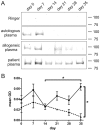Storage-induced changes in erythrocyte membrane proteins promote recognition by autoantibodies
- PMID: 22879923
- PMCID: PMC3411782
- DOI: 10.1371/journal.pone.0042250
Storage-induced changes in erythrocyte membrane proteins promote recognition by autoantibodies
Abstract
Physiological erythrocyte removal is associated with a selective increase in expression of neoantigens on erythrocytes and their vesicles, and subsequent autologous antibody binding and phagocytosis. Chronic erythrocyte transfusion often leads to immunization and the formation of alloantibodies and autoantibodies. We investigated whether erythrocyte storage leads to the increased expression of non-physiological antigens. Immunoprecipitations were performed with erythrocytes and vesicles from blood bank erythrocyte concentrates of increasing storage periods, using patient plasma containing erythrocyte autoantibodies. Immunoprecipitate composition was identified using proteomics. Patient plasma antibody binding increased with erythrocyte storage time, while the opposite was observed for healthy volunteer plasma, showing that pathology-associated antigenicity changes during erythrocyte storage. Several membrane proteins were identified as candidate antigens. The protein complexes that were precipitated by the patient antibodies in erythrocytes were different from the ones in the vesicles formed during erythrocyte storage, indicating that the storage-associated vesicles have a different immunization potential. Soluble immune mediators including complement factors were present in the patient plasma immunoprecipitates, but not in the allogeneic control immunoprecipitates. The results support the theory that disturbed erythrocyte aging during storage of erythrocyte concentrates contributes to transfusion-induced alloantibody and autoantibody formation.
Conflict of interest statement
Figures



Similar articles
-
The proteome of red cell membranes and vesicles during storage in blood bank conditions.Transfusion. 2008 May;48(5):827-35. doi: 10.1111/j.1537-2995.2007.01630.x. Epub 2008 Mar 12. Transfusion. 2008. PMID: 18346024
-
Comparative proteomics of erythrocyte aging in vivo and in vitro.J Proteomics. 2010 Jan 3;73(3):396-402. doi: 10.1016/j.jprot.2009.07.010. Epub 2009 Aug 4. J Proteomics. 2010. PMID: 19660581 Review.
-
Erythrocyte ageing in vivo and in vitro: structural aspects and implications for transfusion.Transfus Med. 2008 Dec;18(6):335-47. doi: 10.1111/j.1365-3148.2008.00892.x. Transfus Med. 2008. PMID: 19140816 Review.
-
Red cell autoantibodies characterized by competitive inhibition of iodine 125 Rh alloantibody binding and by immunoprecipitation of membrane proteins.J Lab Clin Med. 1990 Dec;116(6):805-13. J Lab Clin Med. 1990. PMID: 1701002
-
RBC-derived vesicles during storage: ultrastructure, protein composition, oxidation, and signaling components.Transfusion. 2008 Sep;48(9):1943-53. doi: 10.1111/j.1537-2995.2008.01794.x. Epub 2008 Jun 28. Transfusion. 2008. PMID: 18564399
Cited by
-
Impact of Storage Lesion on Post-transfusion Rise in Hemoglobin.Cureus. 2018 Jul 9;10(7):e2952. doi: 10.7759/cureus.2952. Cureus. 2018. PMID: 30202679 Free PMC article.
-
Effects of Storage Time on Glycolysis in Donated Human Blood Units.Metabolites. 2017 Mar 29;7(2):12. doi: 10.3390/metabo7020012. Metabolites. 2017. PMID: 28353627 Free PMC article.
-
Vesiculation of Red Blood Cells in the Blood Bank: A Multi-Omics Approach towards Identification of Causes and Consequences.Proteomes. 2020 Mar 31;8(2):6. doi: 10.3390/proteomes8020006. Proteomes. 2020. PMID: 32244435 Free PMC article.
-
Age-Markers on the Red Blood Cell Surface and Erythrocyte Microparticles may Constitute a Multi-parametric Strategy for Detection of Autologous Blood Transfusion.Sports Med Open. 2023 Dec 1;9(1):113. doi: 10.1186/s40798-023-00662-9. Sports Med Open. 2023. PMID: 38038869 Free PMC article.
-
Survival of red blood cells after transfusion: processes and consequences.Front Physiol. 2013 Dec 18;4:376. doi: 10.3389/fphys.2013.00376. Front Physiol. 2013. PMID: 24391593 Free PMC article. Review.
References
-
- Bosman GJ, Werre JM, Willekens FL, Novotny VM (2008) Erythrocyte ageing in vivo and in vitro: structural aspects and implications for transfusion. Transfus Med 18: 335–347. - PubMed
-
- Willekens FL, Werre JM, Groenen-Dopp YA, Roerdinkholder-Stoelwinder B, de Pauw B, et al. (2008) Erythrocyte vesiculation: a self-protective mechanism? Br J Haematol 141: 549–556. - PubMed
-
- Lang KS, Lang PA, Bauer C, Duranton C, Wieder T, et al. (2005) Mechanisms of suicidal erythrocyte death. Cell Physiol Biochem 15: 195–202. - PubMed
-
- Antonelou MH, Kriebardis AG, Stamoulis KE, Economou-Petersen E, Margaritis LH, et al. (2010) Red blood cell aging markers during storage in citrate-phosphate-dextrose-saline-adenine-glucose-mannitol. Transfusion 50: 376–389. - PubMed
-
- Messana I, Ferroni L, Misiti F, Girelli G, Pupella S, et al. (2000) Blood bank conditions and RBCs: the progressive loss of metabolic modulation. Transfusion 40: 353–360. - PubMed
MeSH terms
Substances
LinkOut - more resources
Full Text Sources

